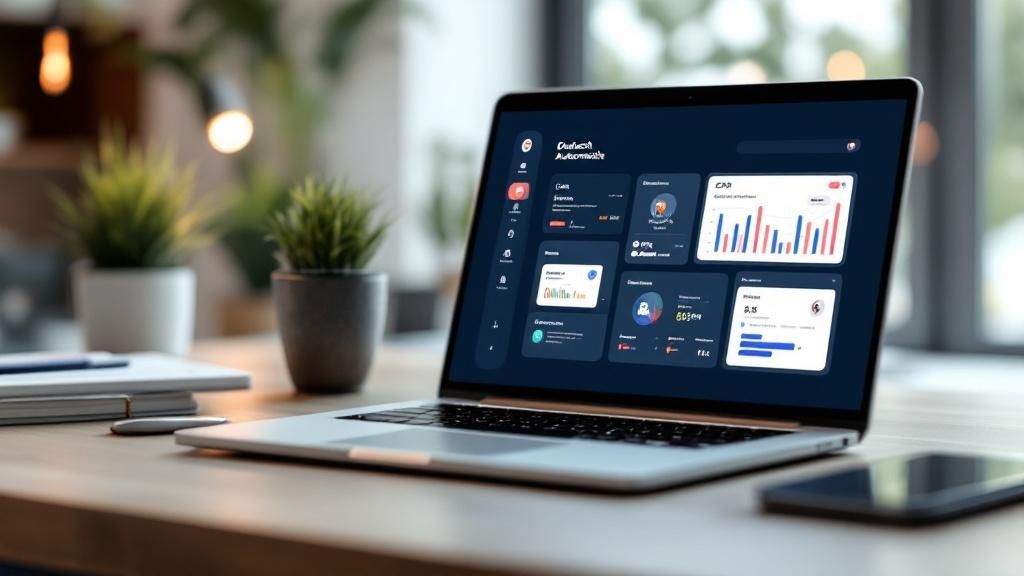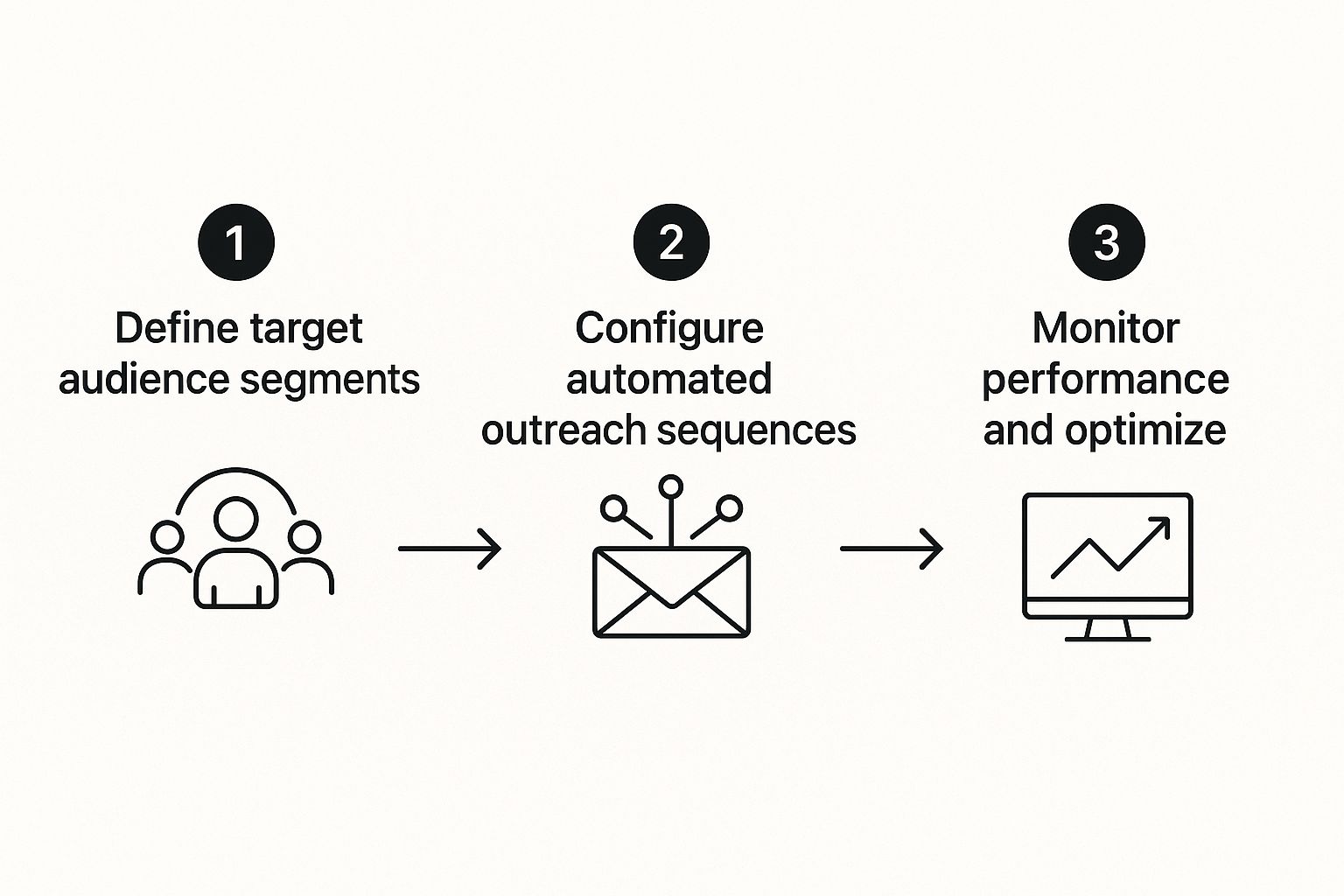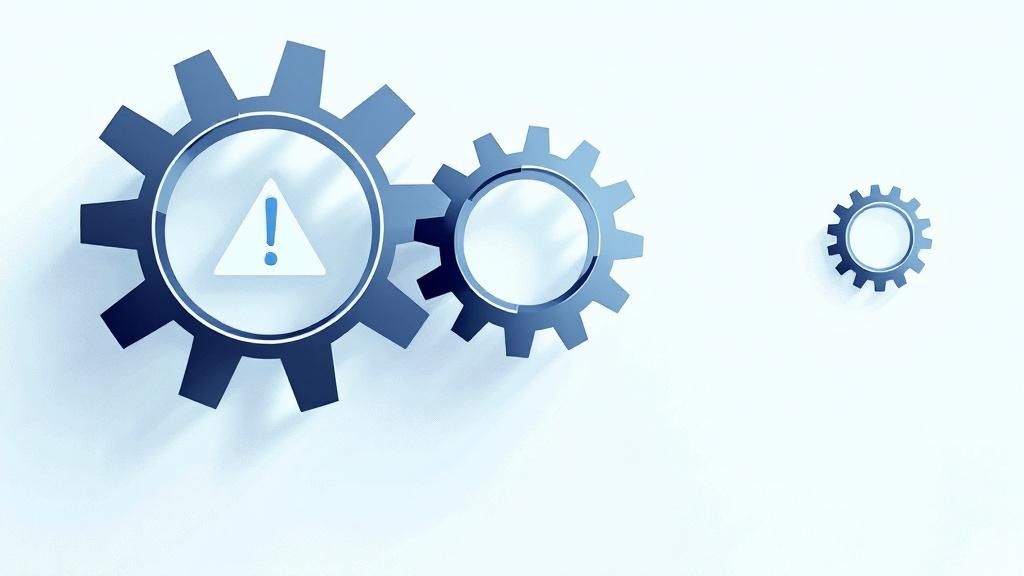Understanding What Sales Automation Really Means Today
Let's clear the air: sales outreach automation isn't about replacing salespeople with robots or endlessly spamming prospect inboxes. Thinking of it that way is like confusing a high-performance sports car with a simple bicycle. While both get you from point A to point B, one dramatically transforms your speed, capacity, and what's possible on the journey. At its core, modern sales automation is a strategic amplifier, giving your team the power to accomplish more in less time, with greater precision.
Instead of your best reps spending hours on tedious, repetitive tasks like data entry, manual follow-ups, or logging activities, automation handles the grunt work. This frees them to focus on what they do best: building genuine relationships, understanding customer needs, and closing complex deals. It’s the difference between manually dialing numbers from a phonebook and having a system that identifies, dials, and preps you for the most promising conversations.
Beyond Simple Email Blasting
True sales outreach automation moves far beyond the old "set it and forget it" email blasts that often did more harm than good. Today's platforms are intelligent systems that integrate deeply with your sales process. They are designed to execute sophisticated, multi-step, and multi-channel sequences that feel personal and relevant to the recipient.
For example, a smart automation platform can:
- Identify high-intent prospects based on their behavior, such as visiting your pricing page.
- Enroll them into a personalized email sequence that references their specific interests.
- Schedule a follow-up task for a sales rep if the prospect opens an email multiple times but doesn’t reply.
- Pause all communication automatically the moment a prospect responds, preventing awkward overlapping messages.
This level of intelligent workflow is becoming essential. The market is shifting decisively toward digital-first interactions, and successful teams are adapting. Projections show that by 2025, digital channels will account for 80% of all B2B sales engagements. Furthermore, 74% of sales professionals expect AI to fundamentally change their roles, signaling a massive operational shift where automation is no longer optional but a requirement for competition. You can explore more about these trends and what they mean for sales teams in this detailed analysis of sales automation statistics.
What Smart Automation Looks Like in Practice
To visualize this, consider how a platform like Salesforce uses automation to guide sales activities.
This screenshot illustrates how automation tools can provide sales reps with a prioritized list of actions, such as which leads to call next or which emails require a follow-up. By analyzing data and engagement, the system guides reps toward the highest-impact activities, ensuring no opportunity falls through the cracks. This systematic approach transforms sales from a reactive process into a proactive, data-driven strategy, enabling teams to scale their efforts without sacrificing the personal touch that closes deals.
Essential Features That Separate Winners From Wannabes

When you're evaluating a sales outreach automation platform, it's easy to get distracted by a long list of features that seem impressive but don't add much real-world value. The screenshot above shows a standard automation dashboard with email sequences and follow-up tasks. These are important, but the true power isn't in the individual functions; it's in how they work together to form an intelligent system.
The best platforms don't just automate tasks—they help automate decisions. This is what separates the real contenders from the tools that look good on the surface but can't deliver results. Let's explore the capabilities that genuinely make a difference.
Core Engine: Sequence Builder and Personalization
Don't be swayed by huge template libraries; they often lead to generic outreach that falls flat. The most critical component is a flexible sequence builder. Think of this as the engine of your outreach strategy. It lets you map out campaigns that use multiple channels and steps, from sending emails to setting time delays and creating reminders for manual calls.
A great sequence builder uses "if/then" logic. For example, it can automatically stop the sequence if a prospect replies or clicks a specific link. This logic is the key to personalizing your outreach at scale. Instead of just inserting a name, advanced personalization uses custom information about a prospect's industry, challenges, or recent company announcements. True personalization shows you've done your research, and a top-tier platform makes it simple to weave these details into your automated messages.
Intelligence Layer: Lead Scoring and Analytics
How do you figure out which prospects deserve your immediate attention? This is where lead scoring becomes invaluable. It acts like a built-in detective, watching how prospects interact with your outreach. A lead might get a few points for opening an email, more points for clicking a link, and a major boost for visiting your pricing page. This system automatically brings your most engaged leads to the top of the pile.
Just as important is a solid analytics dashboard. A useful dashboard does more than show you basic numbers like open rates. It helps you answer important business questions, such as:
- Which email sequence gets the most replies?
- Where in our outreach do most prospects stop engaging?
- Which sales rep has the best conversion rate from their automated campaigns?
These insights allow you to turn raw data into smart decisions, helping you continuously improve your strategy. For instance, incorporating an effective chatbot for lead generation strategies can be another way to use automation to qualify and nurture leads before they even enter a sequence.
To help you distinguish between the must-haves and the nice-to-haves, here's a breakdown of essential versus advanced features.
| Feature Category | Essential Features | Advanced Features | Business Impact |
|---|---|---|---|
| Sequencing & Cadence | Multi-step email sequences, basic time delays, task creation. | Multi-channel steps (social, calls), "if/then" branching logic, A/B testing for messages and timing. | Advanced features allow for more tailored and responsive outreach, adapting to prospect behavior automatically. |
| Personalization | Basic merge tags ({{first_name}}, {{company}}). |
Custom fields based on CRM data, dynamic content insertion based on prospect segments. | Advanced features move beyond generic templates to deliver highly relevant messages that resonate with individual prospects. |
| Analytics & Reporting | Open/reply/click rates, sequence completion metrics. | In-depth funnel analysis, team performance leaderboards, conversion tracking by sequence. | Advanced features provide actionable insights to optimize strategy, not just report on activity. |
| Lead Management | Manual lead prioritization. | Automated lead scoring based on engagement, automatic lead rotation among reps. | Advanced features ensure sales reps focus their time on the most promising leads, increasing efficiency and ROI. |
| Integrations | Basic CRM connection (e.g., Salesforce, HubSpot). | Deep, bi-directional CRM sync, native integration with other sales tools (e.g., dialers, data enrichment). | Advanced features create a unified tech stack, eliminating data silos and manual data entry. |
| Deliverability | Standard email sending protocols. | Email warm-up services, custom tracking domains, built-in spam and bounce analysis. | Advanced features protect your domain's reputation and ensure your messages actually land in the inbox. |
This table shows that while essential features get you started, advanced capabilities are what truly drive efficiency and help you scale your operations effectively.
The Connective Tissue: Integrations and Deliverability
Finally, a platform is only as good as its ability to work with your other tools. Seamless CRM integration is non-negotiable. This ensures all outreach activities are logged automatically and that data flows freely between systems. This connection is your single source of truth for customer information and prevents your team from doing double the work.
On top of that, even the most brilliant automation is worthless if your emails go to spam. Look for platforms that take deliverability seriously. This includes features like email warm-up, custom tracking domains, and spam-checking tools. These technical, behind-the-scenes functions are the unsung heroes that make sure your carefully written messages reach their destination.
How Different Industries Win With Automation

Sales outreach automation isn't a one-size-fits-all solution. Think of it more like a flexible toolkit that can be adjusted to fit the specific needs of any business. The workflow builder above is a great visual for this, showing how you can create unique sequences for different situations. A SaaS company might use automation to guide leads through a lengthy sales process, while a real estate agent could use it to stay in touch with past clients. Let's look at how different sectors put these ideas into practice to overcome their own distinct challenges.
SaaS and B2B Technology
In the Software-as-a-Service (SaaS) world, sales cycles can be long and often require buy-in from multiple people. Automation is key to staying on a prospect's radar without being a nuisance. A smart sequence could begin with an email that pinpoints a specific problem and introduces a solution. If the prospect opens the email but doesn't reply, the system can automatically prompt the sales rep to send a LinkedIn connection request a few days later, followed by another email sharing a relevant case study. This creates a persistent, value-first approach that educates potential customers over time.
This method clearly works. The numbers show that 61% of B2B organizations are already using sales automation. With another 20% planning to adopt it in the next year, it's becoming a standard part of the B2B playbook. For a deeper look at this trend, you can review these sales automation statistics. This principle of scaled communication isn't just for sales; understanding concepts like programmatic SEO tactics in marketing shows how automation is being applied across different business functions.
Real Estate and High-Touch Services
For real estate agents, consultants, and other service professionals, the business is built on relationships. There's a common fear that automation feels cold and could weaken client trust. But when used correctly, it does the exact opposite. It manages the repetitive communication, freeing up professionals to focus on the personal interactions that truly matter.
Here are a few ways they put it to work:
- New Lead Nurturing: A new lead from a website can trigger an automated welcome email, a follow-up text message the next day, and a task for the agent to make a personal phone call.
- Post-Sale Follow-Up: After a deal closes, the system can schedule automatic check-ins at one month, six months, and on the one-year anniversary. This keeps the agent top-of-mind for future business and referrals.
- Thought Leadership: Consultants can automatically share their latest articles or whitepapers with their network, building credibility without the manual grind.
In every scenario, automation ensures consistent contact, so no one falls through the cracks. This is a prime example of how you can personalize your sales outreach at scale, blending automated efficiency with the human touch required for strong professional relationships.
E-commerce and Retail
E-commerce businesses live and die by their ability to turn website visitors into paying customers. Automation is their most effective tool for preventing lost sales. The most classic example is abandoned cart recovery. When a shopper puts items in their cart but leaves without buying, an automated sequence springs into action.
This process usually includes a series of timed emails:
- The Gentle Reminder: An hour after the cart is abandoned, a simple email asks if the customer ran into any issues at checkout.
- The Scarcity Nudge: A day later, another email might mention that the items are popular and stock is limited.
- The Incentive: If the customer still hasn't bought, a final email might offer a small discount or free shipping to help close the sale.
This focused, automated process significantly increases revenue by recovering sales that would have otherwise vanished.
Building Your Automation Foundation Without Breaking Everything
Introducing sales outreach automation can feel like trying to change a tire on a moving car—a great idea in theory, but potentially messy if you don’t have a plan. Successful teams don't just flip a switch and hope for the best. They follow a clear, structured process to secure early wins and build momentum without derailing their current sales operations. The most crucial part, often overlooked, is the prep work you do before sending a single automated email.
This initial phase is about getting your house in order. First up is data hygiene. Launching automation with a database full of messy, outdated, or wrong contact information is a perfect example of "garbage in, garbage out." This leads to high email bounce rates, wasted effort, and can even harm your domain's sending reputation. The time you spend cleaning and updating your CRM data is a fantastic investment. After that, you need to map out your existing sales process to pinpoint exactly which tasks you want to automate and where the real bottlenecks are hiding.
A Gradual Rollout Strategy
Once your data is clean and your processes are mapped, the temptation is to launch everything at once. Resist that urge. A phased rollout is much safer and more effective in the long run. This is where a pilot program proves its worth.
- Start Small: Choose a small, eager group of sales reps to be your test crew. This controlled setting lets you iron out any wrinkles without affecting the entire team's quota.
- Set Realistic Goals: You probably won't triple your sales in the first 30 days. Instead, focus on early success indicators, like better open rates on a specific sequence or the amount of time saved on manual data entry. For a deeper look at what to avoid, our guide on common sales automation mistakes provides solid advice for setting achievable targets.
- Gather Feedback: Your pilot team is your best source of truth. Use their direct experience to adjust workflows, tweak message templates, and spot any training gaps before you go live with the whole company.
This infographic shows the fundamental steps for a successful rollout, from defining your target audience to monitoring and optimizing performance.

As the visual shows, great automation is a continuous loop, not a one-and-done setup. The insights you get from monitoring should always be used to fine-tune your audience and messaging.
To help structure your rollout, here's a typical timeline for implementing a sales automation platform.
| Phase | Duration | Key Activities | Success Metrics | Common Challenges |
|---|---|---|---|---|
| Phase 1: Foundation & Planning | 2-4 Weeks | Clean CRM data. Map current sales process. Define automation goals. Select a pilot team. | 95%+ data accuracy. Clearly documented workflow. Defined KPIs. | Poor data quality. Unclear goals. Resistance from sales reps. |
| Phase 2: Pilot Program | 4-6 Weeks | Configure platform for pilot team. Develop initial email sequences. Train pilot users. | >15% reply rate on sequences. Positive user feedback. Time saved per rep >2 hrs/week. | Technical glitches. Ineffective messaging. Low user adoption. |
| Phase 3: Full Rollout & Training | 2-3 Weeks | Refine processes based on pilot feedback. Train the entire sales team. Integrate with other tools (CRM, etc.). | 90%+ team adoption rate. Smooth CRM data sync. All reps actively using the platform. | Integration issues. Scalability problems. Inconsistent training quality. |
| Phase 4: Optimization & Scaling | Ongoing | A/B test email copy and sequences. Analyze performance data. Add new automated workflows. | Month-over-month increase in meetings booked. Improved lead conversion rates. | Stagnant performance. Failure to adapt strategies. Ignoring new feature updates. |
This timeline shows that a successful implementation is a marathon, not a sprint. Each phase builds on the last, ensuring you create a stable and effective system.
Integration and Customization Challenges
A powerful sales outreach platform needs to communicate smoothly with your other software. This is where integrations are essential. A system that can't sync correctly with your CRM creates frustrating data silos and extra manual work, which defeats the entire purpose of automation. Looking into leading API integration platforms can give you the tools needed to connect your CRM, email client, and other sales tools without a headache.
Finally, consider how much you can customize the platform. The software should adapt to your sales process, not force you to change your process to fit the software. This screenshot from Outreach shows a sales engagement platform where reps can manage their tasks and sequences in a unified dashboard.

An interface like this is valuable because it's customizable. It allows teams to build specific workflows that align with their strategies for different types of prospects. Making the right decisions on customization and integration at the beginning will determine whether your new platform becomes a trusted co-pilot or a constant source of frustration.
Measuring What Actually Matters For Your Bottom Line
Switching on sales outreach automation can feel like opening the floodgates to a river of data. Suddenly, every open, click, and reply is at your fingertips. But true success isn't about collecting the most data; it's about finding the story within it. Focusing on vanity metrics like open rates is like a chef judging a meal by how many people glanced at the menu—it doesn't tell you if they loved the food or will ever come back.
To understand your real return on investment, you have to look past the surface-level numbers. It’s a mental shift from simply tracking activity to measuring meaningful outcomes that affect your business goals.
Establishing Baselines and Identifying Leading Indicators
Before you can know how far you've come, you need to know where you started. This is your baseline. What are your reply rates with manual outreach right now? How long does it usually take to get a prospect from the first "hello" to a booked meeting? Documenting these pre-automation numbers is crucial. Without them, any reported improvements are just wishful thinking.
With your starting point mapped out, it's time to identify your leading indicators. These are the metrics that give you a sneak peek into future success. A closed deal is a lagging indicator; it tells you what already happened. A leading indicator, like a high number of positive replies from key decision-makers, suggests more meetings will be booked next week and more deals will close next month.
Other important leading indicators to watch are:
- Engagement Quality: Are prospects asking thoughtful questions, or are you just getting a lot of "not interested" brush-offs?
- Meeting Book Rate: Of all the positive replies you receive, what percentage turns into a scheduled meeting? This metric shows how effective your call to action really is.
- Sales Velocity: Is automation helping your team move deals through the pipeline faster? You can find out by measuring the time between key sales stages.
For instance, a good reporting dashboard provides a clear, visual story of your sales funnel and how your team is performing.
This type of dashboard helps leaders connect automation activities directly to the bottom line, showing outcomes like closed revenue instead of just outreach activity.
Advanced Optimization and Proving ROI
Once you're consistently tracking the right metrics, you can start making data-driven improvements. This is where you use insights to create a compounding effect on your results. For example, multivariate testing lets you try out different subject lines, email copy, and calls to action at the same time to discover the winning formula more quickly. You could also set up behavioral triggers, like automatically sending a case study to a prospect right after they click a link to a specific feature on your website.
When it comes to proving the value of sales outreach automation, a clear ROI calculation is your best friend. Don't just talk about the time your team is saving. Show the real financial impact:
- Increased Deal Size: Are automated follow-up sequences educating buyers, leading them to purchase more valuable packages?
- Improved Conversion Rates: By how much has your lead-to-opportunity conversion rate increased since you started using automation?
- Reduced Cost of Acquisition: How has better targeting and efficiency lowered the cost of winning a new customer?
By presenting data that ties automation directly to revenue growth, deal speed, and profitability, you change the conversation from "How much does this cost?" to "How much more can we invest in this?"
Choosing Your Platform Partner for Long-Term Success
Selecting the right sales outreach automation platform is less like buying a piece of software and more like choosing a long-term business partner. This decision will ripple through your sales operations, shaping your team's efficiency, ability to scale, and overall growth for years. Because of this, your evaluation must go beyond a simple feature checklist and look at the strategic fit, vendor stability, and the total cost of ownership.
A platform can look perfect on paper, but it can quickly become a problem if it doesn't integrate smoothly with your existing technology, especially your CRM. This connection is the digital backbone of your sales process. When integration is poor, it creates data silos, forces your team into manual workarounds, and ultimately defeats the purpose of automation. Before making any commitment, insist on a clear demonstration of how the platform syncs with your essential tools.
Evaluating Beyond the Demo
A polished sales demo is designed to impress, but it rarely shows the full picture of day-to-day use. To truly understand a platform's value, you need to dig deeper. Here are critical areas to investigate:
- Vendor Stability and Vision: Is the company a new startup or an established player? Ask to see their product roadmap. Does their vision for the future line up with your company's growth plans? A partner that is developing in areas like AI-driven prospecting and multi-channel sequencing will be able to support you as you grow.
- Total Cost of Ownership (TCO): The subscription fee is just the starting point. You need to account for potential hidden costs like implementation fees, charges for premium integrations, required training programs, and costs per contact or email send. A lower monthly fee can be deceiving if the TCO is much higher.
- User Adoption and Support: The most advanced tool is useless if your team finds it clunky or confusing. Ask about the onboarding process and what training resources are available. Test their customer support with specific, tough questions to see how responsive and knowledgeable they are. Ease of use is a critical factor for success.
A great place to start your evaluation is by checking trusted third-party review sites. These platforms gather user feedback on usability, support, and overall satisfaction.

This screenshot from G2 shows a grid of top sales automation platforms, scored by user satisfaction and market presence. It offers an unbiased starting point for your research. The insights in these reviews often reveal practical strengths and weaknesses you won't find on a vendor's website, like the actual ease of setup or the quality of customer support.
Structuring a Meaningful Pilot Program
Once you have a shortlist of platforms, the next step is a pilot program. This is more than just a free trial; it's a structured test designed to confirm the platform's performance against your specific needs. Before you start, define clear success criteria. For example, you might aim to increase your meeting booking rate by 15% for the pilot group or reduce the time spent on manual outreach by three hours per week for each rep.
To help structure this evaluation, you can use a scorecard. This allows you to compare platforms systematically based on what matters most to your team.
Platform Evaluation Scorecard
Comprehensive scoring framework for comparing automation platforms across critical decision factors
| Evaluation Criteria | Weighting | Platform A Score | Platform B Score | Platform C Score |
|---|---|---|---|---|
| CRM Integration Quality | 25% | 9/10 | 7/10 | 8/10 |
| Ease of Use/UI | 20% | 8/10 | 9/10 | 6/10 |
| Feature Set & Roadmap | 20% | 7/10 | 8/10 | 9/10 |
| Customer Support | 15% | 9/10 | 6/10 | 7/10 |
| Total Cost of Ownership (TCO) | 15% | 6/10 | 8/10 | 7/10 |
| User Reviews (e.g., G2, Capterra) | 5% | 8/10 | 7/10 | 8/10 |
| Weighted Total | 100% | 7.9 | 7.6 | 7.55 |
Using a structured approach like this ensures you are making a data-driven decision. When a platform proves it can meet your specific goals, you can move forward to contract negotiations with confidence. Look for flexible terms that protect your interests as you scale, and avoid long-term lock-ins that don't include performance guarantees. The right partner won't just automate tasks—it will actively help you find and engage prospects. If you want to see how this works in practice, you can learn how Salesloop automates your way to more leads and helps teams scale their efforts.
Key Takeaways For Automation Success
Getting automation right is a balancing act. Too much, and you'll alienate prospects. Too little, and you lose out on efficiency. Here’s how to strike the perfect balance and make your automation efforts a genuine success.
Recognize Early Warning Signs
How do you know if your automation is going too far? Your prospects will tell you, often with silence. Think of it like talking to an empty room—if you notice a significant drop in engagement, it’s time to reassess. A 30% drop in reply rate is a major red flag that your messages aren't resonating.
Another clear sign is when your messages are being sent at odd hours, indicating a lack of time-zone awareness. Poor data quality is also a culprit, showing up as high bounce rates and emails addressed to "Hi {{first_name}}." This signals that a clean data foundation is just as crucial as the sequences you build.
Balance Efficiency With Personalization
Automation should work like a skilled assistant, not a robotic broadcaster. It’s there to handle the repetitive tasks so you can focus on building relationships. A simple way to achieve this is by segmenting your audience and using dynamic fields. This small step can transform a generic email into a relevant, one-on-one conversation.
Here’s a quick checklist to keep your outreach human-centric:
- Verify and clean your contact lists every two weeks.
- Use conditional logic to automatically pause sequences when someone replies.
- Include at least one custom sentence that references a prospect’s specific challenge or goal.
- Schedule manual check-ins after every three automated touchpoints.
Maintain Authentic Connections
Even the most sophisticated workflows need a human touch. Your automation platform is the engine that drives your outreach forward, but you are still the one behind the wheel. The most successful teams understand this and dedicate 20% of their outreach time to activities like live calls or personalized video messages. This approach prevents you from sounding robotic and keeps your connections authentic.
Compliance and Quality Controls
Ignoring compliance rules is a fast track to hefty fines and a damaged sender reputation. It's not something you can afford to overlook. Here are the essential protocols to have in place:
| Compliance Area | Action | Frequency |
|---|---|---|
| Opt-out Management | Automate unsubscribe processes | Real-time |
| Data Privacy | Enforce GDPR/CCPA filters | Monthly |
| Domain Reputation | Monitor spam score | Weekly |
Implementation Milestones
A gradual rollout of automation keeps your team aligned and allows for adjustments along the way. Avoid a big-bang launch and instead, break it down into manageable phases:
- Foundation: Start by cleaning your data and clearly defining your audience segments.
- Pilot: Test your new workflows with a small, dedicated team for 4–6 weeks.
- Rollout: Once the pilot is successful, expand the automation to the entire team.
- Optimize: Continuously use performance metrics to refine subject lines, messaging, and timing.
Final Checklist Before Launch
Before you hit "go" on your automation engine, run through this final checklist to ensure everything is in order:
- Confirm that each segment receives content tailored to their industry or pain points.
- Verify that your integrations are logging events correctly without errors.
- Test all unsubscribe links to make sure opt-out actions work instantly.
- Validate the time zones and sending windows for all geographic regions.
- Schedule a weekly audit of your deliverability metrics and data hygiene.
Success Metrics That Matter
Judging your success on vanity metrics like open rates is like measuring a concert's success by the number of tickets scanned. You need to focus on what truly drives growth.
Pay attention to these key indicators:
- Meeting Rate: The percentage of replies that turn into booked calls.
- Pipeline Velocity: The average number of days it takes to move a contact from first touch to a qualified opportunity.
- Revenue Impact: The amount of closed-won revenue directly attributed to your automation efforts.
By tracking these outcomes, you can demonstrate tangible ROI and make smarter decisions about your strategy.
Conclusion
True success in sales automation comes from blending technology with genuine human insight. When you prioritize data hygiene, respect compliance, and weave personalization into every step, automation becomes a powerful growth multiplier, not a blunt instrument.
Ready to fine-tune your sales outreach automation? Explore how Salesloop.io can help you combine efficiency with authenticity, scale your campaigns, and drive measurable results with minimal effort: Get Started with Salesloop.io





